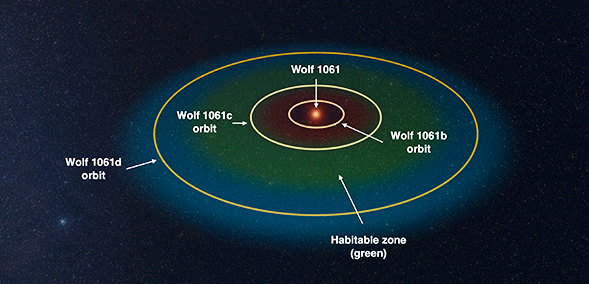Nearby star hosts closest alien planet in the ‘habitable zone’
December 17, 2015

A simulation of the orbital configuration of the Wolf 1061 system. Wolf 1061 is an inactive red dwarf star, smaller and cooler than our sun, 14 light years away. The planetary habitable zone around the star is marked in green — the colors grade from red (where a planet would be too hot), through green (where the surface of a planet could sustain liquid water), through to blue (where a planet would be too cold). (credit: Made using Universe Sandbox 2 software)
UNSW Australia astronomers have discovered the closest potentially habitable planet found outside our solar system so far, orbiting a star just 14 light years away.
The planet, more than four times the mass of the Earth, is one of three that the team detected around a red dwarf star called Wolf 1061.
“It is a particularly exciting find because all three planets are of low enough mass to be potentially rocky and have a solid surface, and the middle planet, Wolf 1061c, sits within the ‘Goldilocks’ zone where it might be possible for liquid water — and maybe even life — to exist,” says lead study author UNSW’s Duncan Wright.
“While a few other planets have been found that orbit stars closer to us than Wolf 1061, those planets are not considered to be remotely habitable,” Dr Wright says.
The three newly detected planets orbit the small, relatively cool and stable star about every 5, 18 and 67 days. Their masses are at least 1.4, 4.3 and 5.2 times that of Earth, respectively. The larger outer planet falls just outside the outer boundary of the habitable zone and is also likely to be rocky, while the smaller inner planet is too close to the star to be habitable.
The discovery will be published in The Astrophysical Journal Letters (an open access article).
Small rocky planets like our own are now known to be abundant in our galaxy, and multi-planet systems also appear to be common. However most of the rocky exoplanets discovered so far are hundreds or thousands of light years away.
An exception is Gliese 667Cc which lies 22 light years from Earth. It orbits a red dwarf star every 28 days and is at least 4.5 times as massive as Earth.
“The close proximity of the planets around Wolf 1061 means there is a good chance these planets may pass across the face of the star. If they do, then it may be possible to study the atmospheres of these planets in future to see whether they would be conducive to life,” says team member UNSW’s Dr Rob Wittenmyer.
UNSW Science | A simulation of the orbital configuration of the Wolf 1061 system. Wolf 1061 is an inactive red dwarf star, smaller and cooler than our sun, 14 light years away.
The orbits for the planets b, c and d (ordered from the inner planet to the outer) have periods of 4.9 days, 17.9 days and 67.2 days. In the simulation we show the planet orbits as all lying in a single plane.
The planetary habitable zone around the star is marked in green – the colours grade from red (where a planet would be too hot), through green (where the surface of a planet could sustain liquid water), through to blue (where a planet would be too cold).
Credit: This simulation was made using the Universe Sandbox 2 software from universesandbox.com
Abstract of Three planets orbiting Wolf 1061
We use archival HARPS spectra to detect three planets orbiting the M3 dwarf Wolf 1061 (GJ 628). We detect a 1.36 M⊕ minimum-mass planet with an orbital period P = 4.888 d (Wolf 1061b), a 4.25 M⊕ minimum-mass planet with orbital period P = 17.867 d (Wolf 1061c), and a likely 5.21 M⊕ minimum-mass planet with orbital period P = 67.274 d (Wolf 1061d). All of the planets are of suffi- ciently low mass that they may be rocky in nature. The 17.867 d planet falls within the habitable zone for Wolf 1061 and the 67.274 d planet falls just outside the outer boundary of the habitable zone. There are no signs of activity observed in the bisector spans, cross-correlation full-width-half-maxima, Calcium H & K indices, NaD indices, or Hα indices near the planetary periods. We use custom methods to generate a cross-correlation template tailored to the star. The resulting velocities do not suffer the strong annual variation observed in the HARPS DRS velocities. This differential technique should deliver better exploitation of the archival HARPS data for the detection of planets at extremely low amplitudes.